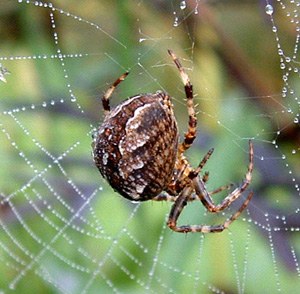Wildlife gardening - Spiders

Many people are scared of spiders but, although a very few can give you a nip, they are very interesting and useful creatures. If there were no more spiders, the whole planet would be swarming with flies. They eat the pest flies that damage our crops and which bite us and our livestock. Life would be thoroughly miserable without them, so every wildlife gardener should be happy to see spiders setting up home.
Amazing Silk
The silk that spiders weave their webs from is incredible stuff - it is tougher by weight than steel, and it is also elastic and waterproof. In Africa there is a spider whose web silk is strong enough to make a net that can hold a fish weighing half a kilo. It has also been said that if you could make a thread of spider's silk the same thickness as a pencil, it would be strong enough to stop a Boeing 747. In the olden days, spider's webs were gathered and used as a bandage to stop bleeding.
Scientists have also been looking at copying spider silk to use in helping to make the next generation of computers.
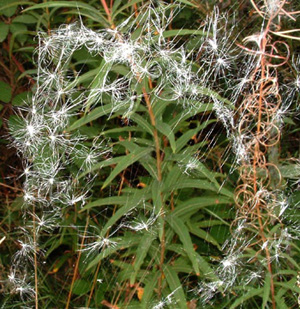
Seeds caught in a cobweb
Whether you like spiders or not, you will probably enjoy the book Charlotte's Web by E. B. White. It is a touching and beautifully written story, telling the tale of the friendship that develops between a pig called Wilbur and a spider named Charlotte and how, by Charlotte's clever plan, she saves his life. Although it is written for children, it is equally enjoyed by adults. I didn't read it till I was 30 and I loved it.
What do spiders eat?
Spiders live on flying insects, including flies, wasps and butterflies. They don't usually eat the smaller insects like aphids. The spider in the picture has caught a butterfly and is in the process of wrapping it up.
There is one type of spider that can catch fish. The very rare fen raft spider is found in eastern England and in one place in Wales. It is found in wet areas where it lives on the surface of pools and ditches.
The fen raft spider is nearly an inch long and has very hairy legs that allow it to walk on the surface of water.
It usually lives on pond skaters and dragonfly larvae but can catch tadpoles and sticklebacks.
Before eating their prey, spiders usually first wrap them in silk before injecting them with venom. The spider will then take its meal to the edge of its web, where it will eat it.
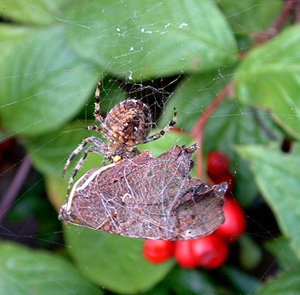
A garden spider with a caught butterfly
Why don't spiders stick to their own webs?
Spiders don't stick to their own webs because not all the threads are sticky. They connect the main spokes first, and then add in the connecting threads. The main spokes are the non-sticky ones and it is the connecting threads that are sticky.
There is also a central 'hub' to which the main spokes are connected. These aren't sticky either and this is where the spider will often sit and wait for a meal to be caught in the sticky part of the web.
Sometimes they will wait in a hiding place at the edge of the web, usually under a leaf.
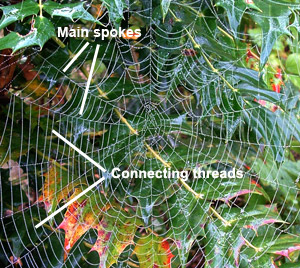
Not all of the threads in a spider's web are sticky
Some different types of spider
The garden or orb-weaving spider
The garden or orb-weaving spider
The spider seen most often is the garden or orb-weaving spider (Aranaeus diadematus). They are quite big and round, with the female being larger than the male. The colour of the garden spider varies from pale to very dark brown, but they all have similar markings.
Garden spiders are most visible in summer and autumn, when they can be seen sitting, head down, in the centre of their large and beautiful webs, waiting for their next meal to come along and get stuck in it, when they will rush out and wrap it in silk.
They build their webs in shrubs, across paths and in doorways. The web is quite large and has a recognisable spiral pattern. Walk along any country lane in autumn and you will see that the hedgerows are festooned with large webs, each with a spider at the centre.
After mating the garden spider makes a silk cocoon into which she lays her eggs. She will stay with the cocoon, protecting it, until she dies in autumn. The eggs will hatch in the following early summer.
Wolf spiders (Pardosa amentata) are often seen together in groups and at one time it was thought that they hunted in packs, hence the name.
Unlike many other spiders, wolf spiders live mainly on the ground and they don't use a web to catch their prey. Instead, they simply jump on them and eat them.
Wolf spiders are not as big as the garden spider, being only about 5mm long. They like the sunny clearings at the edge of woodland, which is where the one in the picture was seen. I have no idea why it was sitting next to a ladybird, but I saw this peculiar arrangement more than once that day, all of them sitting next to each other on nettle leaves. If you look closely, you can see that the spider is touching the ladybird with one of its legs, and also that it has one leg missing.
After mating the female constructs an egg sac which she attaches to her spinnerets (where the silk comes out) and keeps with her until the eggs hatch. Once the eggs are hatched, the female discards the sac and the spiderlings climb onto her back, where they will stay for about a week.
Wolf spiders
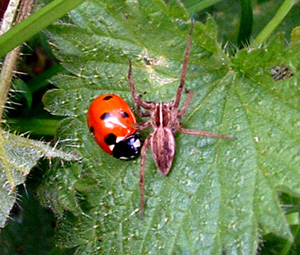
A wolf spider and a ladybird on a nettle leaf
Lesser garden spiders
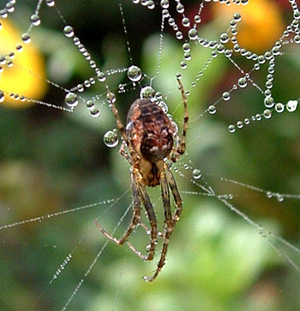
A lesser garden spider on a dewy web
The lesser garden spider (Metellina segmentata) is similar to the orb-weaving spider, but it is smaller and slimmer and with longer legs.
They also weave similar webs to the larger garden spider. Like other spiders, if the lesser garden spider's web is damaged, it will eat it to conserve protein.
They are common in all habitats - gardens, woodland, grassland and hedgerows - and are also known to favour oak trees.
Orb-weaving spiders have been around for a very long time. A specimen found trapped in a piece of ancient amber is thought to be between 115 and 121 million years old. The oldest spider trapped in amber is about 135 million years old. Both specimens are in a museum in Spain, the Museo De Ciencias Naturales De Alava, in Vitoria.
Harvest spiders, or harvestmen, (order Opiliones) are not true spiders, and you can tell this because their bodies are globular, rather than being in two sections like true a spider's body. Most have long legs, with the second pair being the longest. Harvestmen also differ from spiders in that they only have two eyes, rather than the usual eight.
They are also different from true spiders in that they do not produce silk and have no venom.
Harvestmen are omnivorous and will eat almost anything, from dead slugs to strawberry jam and even bird droppings. They obtain water either from drinking drops of dew on leaves or from attacking plant matter for the liquid inside it.
Although harvestmen are mainly nocturnal, they can be seen during the day resting on walls and fences, or on plants, like the one in the picture.
They are called harvestmen, or harvest spiders, because that is when they are mature and most to be seen.
The harvest spider
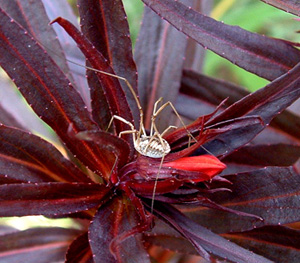
Harvest spiders are not true spiders
Jumping spiders
Not pictured here, but worth looking out for in the house and garden, is the jumping spider (you can tell what it is as soon as it moves because, as the name suggests, it jumps rather than scuttles). This spider is a hunting spider and does not make a web to catch its prey, but leaps on it, often from several inches away. Jumping spiders do use silk, though, for tethering themselves in case of falls and for constructing shelters for use when moulting or to protect their eggs.
Jumping spiders are quite inquisitive and don't run away in the same way that many other spiders do. Sometimes, you can have a little game with them. If you see a jumping spider on a flat surface, take a hair from your head (or someone else's if yours is short) and very slowly drag it along a few inches in front of the spider. With luck, the spider will pounce on the hair, just as a kitten does with balled paper on a string.
How to help spiders
Having plenty of shrubs in the garden will give spiders somewhere to make their webs. By not using pesticide sprays, there will be more insects for the spiders to eat and this will also help to stop you poisoning them.
Many spiders only live for a year or two and a lot of them die over winter which is why, in late autumn, you may find spiders coming into the house. This is because they are looking for a warm place to hibernate for the winter.
If you don't mind a couple of spiders in the house, you can help them by making sure they don't die of dehydration in your centrally heated home. Do this by putting down a small shallow dish of water where spiders can find it - on the floor in a corner is a good place, but don't forget to top it up. Putting a few small pebbles in the dish, big enough so that the tops are above the water level, will help the spiders get to the water.
Sometimes spiders overwinter in kitchens. A corner of a window frame, next to where the window opens, is a popular place, especially if they have an egg sac to protect. If you have a spider in a spot like this, keep an eye on it when the windows mist up during cooking. Often, the spider will come down from its hiding place and begin to 'harvest' the moisture with its front legs, dragging them across the misted glass and leaving a sort of herringbone pattern behind.
When the windows don't mist up, you can flick a few drops of water onto the glass near to the spider, and it may well come down and partake of a couple.
If you don't want spiders in the house - don't kill them, but carefully catch them in a glass and gently put them outside.

© Copyright Miranda Hodgson 2007
